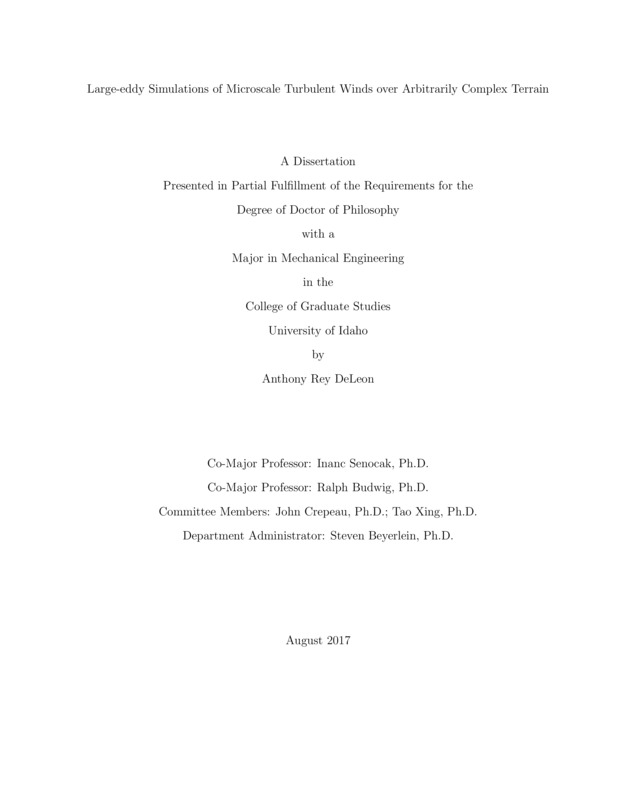Large-eddy Simulations of Microscale Turbulent Winds over Arbitrarily Complex Terrain
DeLeon, Anthony Rey. (2017). Large-eddy Simulations of Microscale Turbulent Winds over Arbitrarily Complex Terrain. Theses and Dissertations Collection, University of Idaho Library Digital Collections. https://www.lib.uidaho.edu/digital/etd/items/deleon_idaho_0089e_11186.html
- Title:
- Large-eddy Simulations of Microscale Turbulent Winds over Arbitrarily Complex Terrain
- Author:
- DeLeon, Anthony Rey
- Date:
- 2017
- Keywords:
- Complex Terrain Immersed Boundary Methods Large-eddy Simulation Log-layer Mismatch Turbulent Inflow Generation Wind Flow
- Program:
- Mechanical Engineering
- Subject Category:
- Mechanical engineering
- Abstract:
-
As the percentage of wind energy continues to increase in the overall energy portfolio, two essential components of integrating wind energy are designing wind turbines to withstand the forces created by the wind and correctly predicting the power production from wind farms. Accurate wind modeling over complex terrain is paramount to both applications. Existing wind forecasting techniques use computational resolutions on the order of a kilometer, whether the terrain be flat or complex. In this dissertation, a computational framework that applies the large-eddy simulation (LES) technique with resolutions on the order of 10 m is developed to improve predictions of turbulent winds over complex terrain. LES is a computationally expensive technique and a distinguishing aspect of the proposed framework is that the entire simulation is developed for massive-parallelism using clusters of graphics process units (GPUs). To reduce the near-wall resolution requirements, Reynolds-averaged Navier-Stokes (RANS) is used in tandem with LES as a wall-model. The hybrid use of RANS and LES leads to modeling artifacts such as a mismatch in the theoretical logarithmic law-of-the wall. A forcing technique that splits the driving mean pressure gradient based on conservation of mass principle is proposed. The split-forcing approach was found to reduce the modeling artifacts on coarse grids. A new turbulent inflow condition based on buoyancy perturbations is proposed for both smooth-wall-engineering and complex-terrain flows. For complex terrain winds, an improved immersed-boundary method is developed based on the equilibrium assumptions in the atmospheric surface layer, along with a pre-processor to process terrain geometry. The computational framework and individual components are thoroughly tested and validated using well-known benchmark cases. Finally, the computational framework is applied to study the feasibility of dynamic line-rating concept over complex terrain. Potential avenues of further research are also recommended.
- Description:
- doctoral, Ph.D., Mechanical Engineering -- University of Idaho - College of Graduate Studies, 2017
- Major Professor:
- Senocak, Inanc; Budwig, Ralph
- Committee:
- Crepeau, John; Xing, Tao
- Defense Date:
- 2017
- Identifier:
- DeLeon_idaho_0089E_11186
- Type:
- Text
- Format Original:
- Format:
- application/pdf
- Rights:
- In Copyright - Educational Use Permitted. For more information, please contact University of Idaho Library Special Collections and Archives Department at libspec@uidaho.edu.
- Standardized Rights:
- http://rightsstatements.org/vocab/InC-EDU/1.0/

